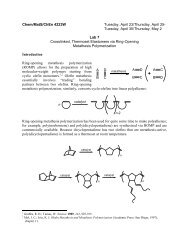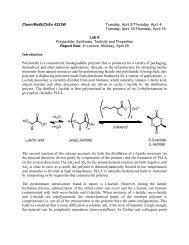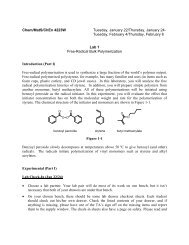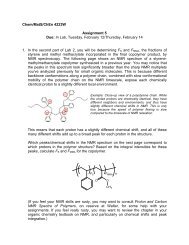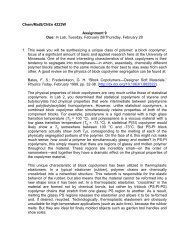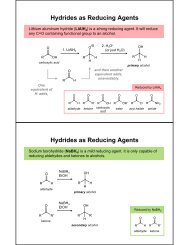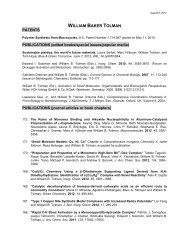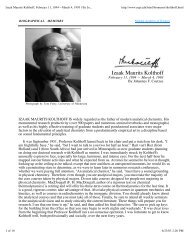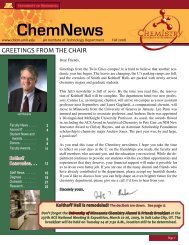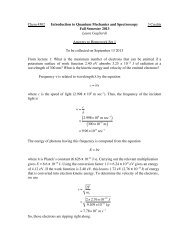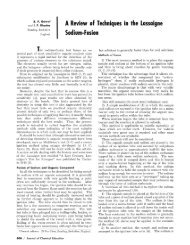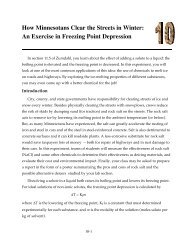Inverse Opal Photonic Crystals - Department of Chemistry ...
Inverse Opal Photonic Crystals - Department of Chemistry ...
Inverse Opal Photonic Crystals - Department of Chemistry ...
You also want an ePaper? Increase the reach of your titles
YUMPU automatically turns print PDFs into web optimized ePapers that Google loves.
Figure 11. Left: Photograph <strong>of</strong> a PMMA colloidal suspension smeared on a black bench top. A successful<br />
preparation will yield a sample that changes from a white milky liquid to a colorful iridescent powder upon drying.<br />
Right: Photograph <strong>of</strong> a dried PMMA colloidal suspension on a glass slide. A successful product will appear<br />
colored, and change colors with angle <strong>of</strong> observation.<br />
C. Cleanup <strong>of</strong> polymerization apparatus<br />
Clean the flask and stirring apparatus with water. If any PMMA remains stuck to the flask or<br />
stirrer (which is usually the case), the instructor should add a 50:50 mixture <strong>of</strong> THF and acetone<br />
to the flask, and heat at 50 o C for a few hours. This solvent mixture will dissolve any remaining<br />
polymer. Pour the solvents into a waste bottle when done, and rinse the flask and stirrer with<br />
acetone.<br />
D. Packing the spheres into a colloidal crystal<br />
1. Place the centrifuge tubes into their buckets, and fill the tubes with the colloidal PMMA<br />
suspension. Add the same amount to each tube to ensure the centrifuge will be balanced<br />
(placing samples with different weights into a centrifuge will cause it to shake vigorously).<br />
Cover the tubes with Parafilm. Place the buckets on the rotor in the centrifuge. Close the<br />
cover and set the rotation rate at about 1500 rpm. Start the centrifuge, and let the samples<br />
spin for one day.<br />
2. Stop the centrifuge, and remove the samples.<br />
You should see a clear liquid in the top portion<br />
<strong>of</strong> tubes, and a white solid at the bottom. If you<br />
don’t see this separation, the samples will<br />
require further centrifuging. Carefully decant<br />
(pour gently) the liquid into a waste bottle. Set<br />
the centrifuge tubes containing the PMMA<br />
colloidal suspensions upright in small beakers.<br />
Let the samples sit open for 3 to 4 days to dry.<br />
The samples are dry when the colloidal crystal<br />
pellets <strong>of</strong> PMMA easily come out <strong>of</strong> the tubes<br />
when tipped over. High quality PMMA will<br />
exhibit bright opalescence on the top surface <strong>of</strong><br />
the pellet (Figure 12).<br />
Figure 12. Photograph <strong>of</strong> the smooth top<br />
surface <strong>of</strong> a PMMA colloidal crystal pellet<br />
illuminated with white light. A benchmark<br />
<strong>of</strong> a successful polymerization is the<br />
appearance <strong>of</strong> opalescence with intense<br />
colors.<br />
21



